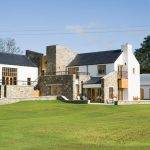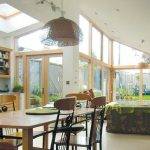New products recently introduced on the Irish market include a new generation of MDF (medium density fibreboard) and timber effect aluminium boards. Acetylated wood fibre MDF in particular offers a durability superior to red cedar. Alternatively, aluminium panels with a powder-coated timber effect finish, available in lengths of 6m and widths of 200-300 mm, can also give this unique timber shiplap finish.
Brick
The word “brick” actually refers to the size and shape, not the material, which, as well as clay, includes bricks made from calcium silicate (sand, lime and sometimes crushed flint as well) and those made from concrete (crushed rock mixed with Portland cement). About 90% of bricks though are made from clay, but all bricks are made to a standard measurement. Anything bigger is called a block.
Facing bricks are used on the outside and can include any of the following. Because they are for external use, they tend to be consistent in colour and texture to give a good appearance.
Wire cut bricks refers to how the extruded strip of clay is cut prior to firing. Multi coloured bricks occur where the colouration of the brick varies across its surface so that every brick in the batch is different.
Specials are bricks of different shapes needed to form an arch for example, turn a corner and for sills, caps, chamfered edges, etc. There is a large range of ‘standard specials’ manufactured commercially. If you want something very special such as a name, date or coat of arms, then a mould can be made and the brick shaped by hand.
[adrotate banner="58"]Handmade bricks sometimes have curved crease marks on their surface which is generally rougher and, in multicoloured varieties, black spots from particles of fuel added to the clay mix to aid in the thorough burning of the brick during firing.
Reclaimed bricks are popular with many people because of their attractive weathered appearance. More expensive than new bricks and the need for careful selection with regard to frost resistance are just two of the potential pitfalls for the innocent individual.
Concrete bricks have characteristics that are slightly different to those made from clay, but with as many colour variations and surface finishes. Concrete facing bricks have a lower water absorption, are manufactured to the strength required whether as wall or paving material, and, being denser than clay, can be useful where noise reduction is important. Because they don’t chip easily this reduces wastage on site and there is also continuity of supply and colour so it is not necessary to either order all the bricks you need at the start, or sort for colour matching. All concrete bricks are fully frost resistant and efflorescence free.
The information following is principally related to bricks made from clay, but, given the exceptions listed above, it is essential that you check all the details regarding use and suitability carefully with the technical representatives of the manufacturer.
Fit for the Job All bricks are classified into groups for frost resistance and soluble salt content. (Except concrete ones above which do not suffer from this.)
Frost resistant (F2) Bricks are durable in all building situations including those where they are in a saturated condition and subjected to repeated freezing and thawing.
Moderately frost resistant (F1) Bricks are durable in all situations except when in a saturated condition and subject to repeated freezing and thawing.
Non frost resistant (F0) Bricks are liable to be damaged by freezing and thawing if not protected as recommended in BS 5628-3:2005 during construction and afterwards, e.g. by an impermeable cladding. These bricks may be suitable for internal use but are rarely made in Ireland or the UK due to their limited applications.
Soluble salt content classification is as follows: S0 bricks are suitable for completely dry applications, S1 are suited to normal exposure and S2 are made for prolonged saturation applications.
Moderately frost resistant (F1) bricks are perfectly suitable for external walls where the rain will run off. They are not suitable for sills, copings, etc., and generally anywhere water could pool. They should not be constructed with a recessed joint mortar profile as this tends to allow water to lie in the joint.
Frost resistant bricks should be used anywhere water might lie (flat surfaces and brickwork immediately below these for example), as saturated brick when frozen will be permanently damaged. The golden rule is to choose bricks according to the exposure of each part of the building. The soluble salt content is most important when it comes to using the correct mortar because soluble sulphates can damage the cement. Water absorption is significant for DPC (damp proof course) bricks in houses and rain penetration. In the first case they will help to reduce the possibility of damp rising into the main brickwork through a ‘wicking’ effect, and in the second, for brickwork where resistance to wind driven rain is important. Remember though that whilst these bricks are of help to keep the building dry, of greater importance is using solid mortar joints, clean cavity construction, correctly positioned and installed DPCs, cavity trays, etc.


